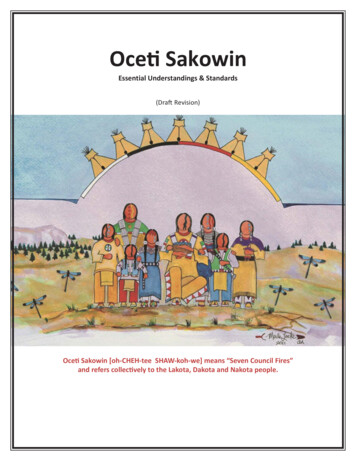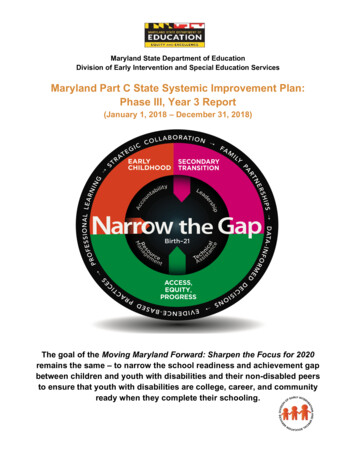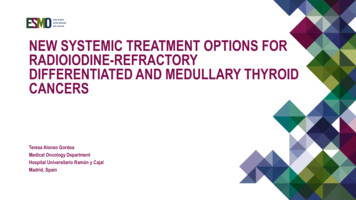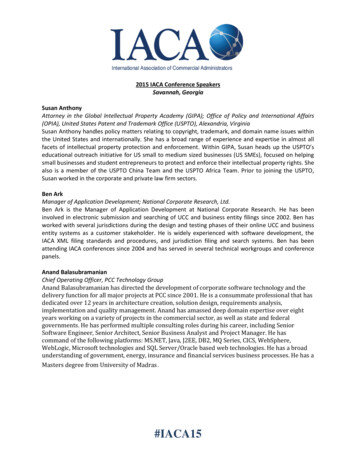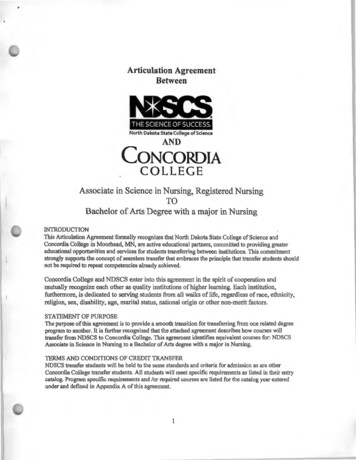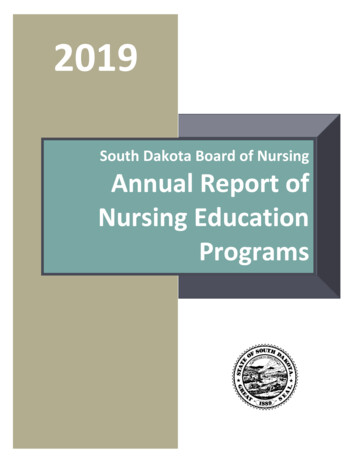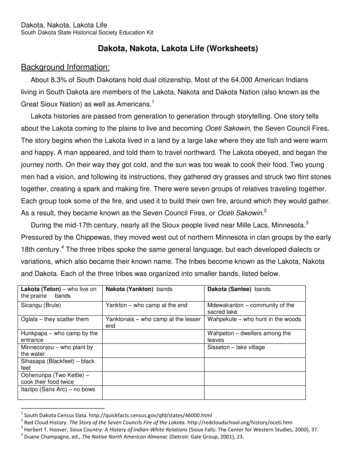
Transcription
North Dakota State Systemic Improvement Plan (SSIP)FFY 2018 Report1
Table of ContentsTopicPageSection 1: Executive Summary . .4IntroductionOverview of System Structure, Scale-Up, Practice Change, SustainabilityOverview of SSIP PhasesPhase 1Phase 2Phase 3Phase 4Section 2: Theory of Action . 8Section 3: State-identified Measurable Result (SiMR)SIMR Progress . .10Section 4: Status of Infrastructure Improvement Strategies . 11Data Quality Improvement StrandChild Outcome ToolFidelity and Inter-Rater Reliability of Child Outcomes ToolND DPI Strategic InitiativeCritical QuestionsElectronic Database ImprovementProfessional Development Improvement StrandProfessional Development WorkgroupPDSA CyclePD Content AreasPD Content Area DevelopmentStakeholder SurveyService Coordination Caregiver Feedback SurveyService Coordination Caregiver Feedback SurveyPD BudgetPolicy and Procedures Improvement StrandPolicy and Procedure Action Strand Improvement PlanPolicy WorkNew PoliciesAPR Overview InfographicInfrastructure ImprovementSection 5: Status of Evidence-Based Practices .23Evidence-Based Practice Improvement StrandEvidence-Based Action Strand Improvement PlanNew Child Outcome Tool2
Evidence-Based PracticesImplementation Science and LeadershipCaregiver Survey: Gathering Family InputParents Interacting With Infants (PIWI) Leads ProjectPIWI Pre-SurveyPIWI Post-SurveyPIWI Pre/Post Survey DataPIWI FidelityPOWR Project Leadership Scale-UpPOWR FidelityFacilitating Attuned InteractionsStatewide SPARK Professional DevelopmentCross-Agency CollaborationSection 6: Status of Infrastructure Improvement Strategies 33SSIP DisseminationData QualityProfessional DevelopmentEvidence-Based PracticesPolicy and ProceduresSection 7: Plans for Next Year . .36Data QualityProfessional DevelopmentEvidence-Based PracticesPolicy and ProceduresTechnical AssistanceSection 8: Appendices 38Appendix A Theory of ActionAppendix B Action Strand Improvement Plan TablesAppendix C SSIP Evaluation TablesAppendix D 508 Compliance3
Section 1: Executive SummaryIntroductionOverview of System Structure, Scale-Up, Practice Change, Sustainability. The SSIPprocess offered North Dakota a structure for systematic review, planning, andimplementation for infrastructure and practice change all leading to improvement in theState Identified Measurable Result (SiMR). Stakeholder involvement and implementationscience has been pivotal to the change process and improvement in North Dakota’s PartC system. The SSIP provided systematic strategic planning for infrastructure,sustainability, appropriate use of resources, leadership development, and scale-up ofevidence-based practices. This Phase III, Year 4 SSIP report details how this processhas culminated in innovative changes for the Part C system in North Dakota.The SSIP structure supported strategic planning, stakeholder involvement, infrastructureimprovement, and implementation supports. Stakeholders were integrated at every levelof planning and decision-making including, caregivers, service coordinators/earlyintervention (EI) program staff, community partners, Inter-Agency Coordinating Council(ICC), statewide agency partners, and cross-sector workgroups. Implementation iscarefully considered and informed by qualitative and quantitative data based upon theevaluation plan. This structure was vital to practice change in North Dakota, which willbe discussed below.North Dakota Early Intervention looks forward to building on the infrastructure andprogress of the SSIP work in the state. NDEIS is enthusiastic about the significant growthin early intervention in the areas of professional development, data quality, policy andprocedure, and evidence-based practices through broad stakeholder involvement. NorthDakota is pleased to share the progress in SiMR improvement yearly, implementation ofa new child outcome tool, statewide scale-up of Parents Interacting With Infants (PIWI)and Partnering for Outcomes With Real meaning (POWR) Project, and the creation anduse of professional development materials. This commitment of the field has improvedservices to families of young children through demonstration of real practice change.Overview of SSIP PhasesThe following provides an overview of the three phases of the SSIP in North Dakota,ending with an update with our work in Phase III, year 4.Phase I. Initially, the state completed an analysis and drill down of data and infrastructureto identify the State Identified Measurable Result (SiMR) and Theory of Action with fourstrands (Data Quality, Professional Development, Evidence-Based Practices, and Policyand Procedures) with stakeholders. The chosen SiMR was:4
There will be improved social emotional outcomes for children who come in belowage expectation but make substantial gains (Indicator 3a, Summary Statement 1)while involved with 1 identified provider as a result of participation in earlyintervention.The lead agency utilized a systematic process to engage broad stakeholder input toidentify a root cause of concern, which was improving understanding the components toidentify and support young children with social emotional challenges and the need of anew tool to measure child outcomes, allowing for systematic training for staff and parentfeedback. The two key areas of needed improvement were identified as promoting bestpractice screening and assessment practices and promoting knowledge ofsocial/emotional/behavioral development. These key areas were derived from the dataand infrastructure analyses. Action steps were developed to support the improvementstrategies to increase the confidence and competence of EI staff and parents/families inthese areas.Phase II. In Phase II, ND spent considerable time with Stakeholders, considering and,ultimately, deciding upon the activities and steps to achieve the coherent improvementstrategies and creating the Action Strand Improvement Plan and Evaluation Plan. In eachsubsequent SSIP report, these were updated in the Appendices. Stakeholders discussedthe rationale for the SiMR, strategies, and targets. There was considerable discussionregarding the measurement process of child outcome summary statements, timely data,and valid and reliable measurement. Stakeholders considered the adoption of a new childoutcome tool, the process of choosing the tool, and the important components of the tool,along with the urgency of moving forward. Stakeholders brainstormed local and statewideinitiatives to partner within the area of social emotional.Strategies of professional development, parent involvement, mentoring/coaching,evidence-based tools, and evidence-based intervention in the area of social emotionalwere finalized. Training around evidence-based assessment, positive behavioralsupports, resiliency and mindfulness strategies for families, using the new tool forprogress monitoring, and supporting social emotional skills were completed. The Statecontinued edits of the electronic data system to ensure more consistency in data entry.The survey methodology for collecting information for Indicator 4, Family Outcomes, wasupdated with the goal of increasing participation and demographic representation. TheState drilled down on Indicator 3, Child Outcomes, to better understand how other factorsaffect performance, i.e. socioeconomic status, access to other public supports, types ofservices accessed, frequency of service accessed, etc.5
Phase III. The components prioritized for the completion of the first year of Phase III wereidentified as Professional Development and Evidence-Based Practices, as it was felt thatthese foundational components would inform the work to be done. Broad stakeholdergroups were utilized for extended feedback in a Plan-Do-Study-Act (PDSA) cycle as thework continued; the Professional Development (PD) stakeholder workgroup developed astate Professional Development Framework with consensus from staff, providers, andcaregivers. The PD workgroup developed timelines to phase-in the PD system. The initialcontent areas were chosen to follow the referral process to intervention. ProfessionalDevelopment modules in triadic strategies were created and assessed with surveys fromstakeholders, and work continued in the area of writing functional outcomes for teams.Stakeholder groups around social-emotional foundations and challenging behaviorsbegan meeting, while training was developed and delivered.The development of components/criteria of a new child outcome tool were completed withthe input of stakeholders, and a Request for Proposal (RFP) was issued in January 2016and awarded in March 2016. Work began to schedule training, incorporating Section 619,so that both ND EIS staff and Section 619 staff could be trained together, in the hopesthat this would continue to foster smooth and seamless transitions for children and theirfamilies. North Dakota replaced the child outcomes assessment tool in the fall of 2017with the Assessment, Evaluation, and Programming System (AEPS). Planning forupcoming work in the policy and procedure strand took place, to ensure the child outcometool, as well as the professional development system, could be incorporated into policyand procedure. The State has sought a group of stakeholders to form a workgroup toreview current policy, as well as assist in writing any new policy and procedure.In Phase III, year 3, the focus moved from the pilot region to scale-up of the statewideevidence-based practice. The pilot region chose to use the Parents Interacting WithInfants (PIWI) modules from the Pyramid model to promote staff social-emotionalcompetencies. Using the PIWI was also strategic in supporting the challenges reported ina previously completed caregiver survey. A PIWI Leads project was used to scale-upstatewide. The PIWI Leads group allowed local service coordinators and earlyinterventionists to locally utilize leadership development and scale-up evidence-basedpractices with state supports and mentorship. A PIWI pre-survey was completed duringthis phase with a post-survey in Phase 4 to capture practice change.Phase III, Year 4. SSIP activities for April 2019 through March of 2020 occurred in eachof the strands. The activities are outlined in detail in the body of the report and statusnoted in the Action Strand Improvement Plans in Appendix B and the Evaluation Tablesin Appendix C.6
In the Data Quality Improvement Strand, the child outcome tool was fully implementedand an interrater reliability tool was made available for the NDEIS professionals. Theelectronic database, Therap, continues to be improved with enhancements to the systemin an ongoing and sustainable process. A Question and Answer document (Q&A)continues to be updated for EIS. There has been a decrease in individual questions beingsent to the Part C Coordinator since the creation of the Q&A Document, resulting in itbeing updated every other month instead of each month. A Data Drill-Down Group madeof NDEIS professionals was formed in August 2019 to provide an opportunity for localprograms to examine their own APR data and have discussions about data reliability inrelation to current data collection practice. The Data Drill-Down Group has met threetimes since the initial meeting in August.In the Professional Development Improvement Strand, the PD stakeholder workgroupworked closely with state the Technical Assistance team to finalize and review data forthe service coordination training materials, which were developed and studied over thelast year. A service coordination NDEIS feedback survey and caregiver feedback groupwere used to gather input and feedback about the materials. EI polycom stakeholderswere also used to gather input and feedback in the area of PD.In the Evidence-Based Practices Improvement Strand, the Parents Interacting WithInfants (PIWI) Leads Project, Caregiver Feedback Survey, SPARK training and PreschoolDevelopment Grant (PDG) collaboration were completed. The PIWI Leads Project wasscaled statewide to support the PD framework for social emotional supports for familiesin creating program leaders at the local level with state level support. The PIWI leadsproject demonstrated significant growth in practice change. A Caregiver Feedback Surveywas completed to demonstrate fidelity with the Pilot Region work of the state evidencebase practice, DEC Recommended Practice F6. The PDG supported statewide SPARKtraining for NDEIS professionals.In the Policy and Procedure Improvement Strand, the Policy and Procedure Workgroupcontinued work with the Part C Coordinator to develop new procedural documents formeeting agendas for 2.7 and 2.9 Transition Meetings. These documents will be reviewedby North Dakota’s Part B 3-5 partners at the ND Department of Public Instruction (DPI)prior to release. An APR infographic overview was created and shared with NDEISprofessionals to increase understanding of the program role in accurate and timely APRdata.7
Section 2: Theory of ActionBelow is the Theory of Action that was developed in Phase I and revised in Phase II bythe State Part C Team, with input from Stakeholders. No additional changes have beenmade to the Theory of Action since it’s submission with Phase II. For ease of review, theTheory of Action can be found, to scale, as Appendix A.Figure 1.In the Theory of Action, the State Part C team and Stakeholders determined that thereare four areas that need to be improved to reach the SiMR. They are: Data Quality Professional Development Evidence-Based Practices Policy and ProcedureIn considering these four Action Strands, the State Part C Team and Stakeholders agreedupon the following Coherent Improvement Strategies: Data Qualityo North Dakota will select and implement a new child outcome tool.o North Dakota will enhance its data system to ensure that valid and reliabledata are available. Professional Developmento North Dakota will design and implement a statewide professional learningsystem with core features including mentoring and coaching. Evidence-Based Practice8
o North Dakota will develop and implement training on the new child outcometool.o North Dakota will select and facilitate implementation of evidence-basedintervention practice(s).Policy and Procedureo North Dakota will review policies and develop necessary procedures toensure implementation of high-quality Early Intervention practices asnecessary to improve social/emotional results of children and families.NDEIS (North Dakota Early Intervention System) continues to use the Theory of Actionas a foundation for the SSIP work. The action strands and coherent improvement servedas a roadmap to guide the state in the important work of moving the quality of earlyintervention forward for North Dakota families.9
Section 3: Status of the State-identified Measurable Result (SiMR)North Dakota Early Intervention System (NDEIS) State Systemic Improvement Plan(SSIP) continues building on the work completed during Phase I, Phase II, and Phase III,focusing on implementation using evidence-based practices with children and theirfamilies, which will support an increase in the State-identified Measurable Result (SiMR):There will be improved social emotional outcomes for children who come inbelow age expectation but make substantial gains (Indicator 3a, SummaryStatement 1) while involved with 1 identified provider as a result of participationin early intervention.SiMR Progress. For FFY 2018, North Dakota demonstrated no slippage in the statetarget in for the SiMR (summary statement A1) from FFY 2017 (see Table 1 below). It isimportant to note that the state began using a new tool, Assessment, Evaluation andProgramming System (AEPS), on October 1, 2017. The number of children included inthe data set for the new tool, AEPS, continues to grow every month as the state transitionsto a full cohort by FFY 2020. As the transition to the AEPs continues, North Dakota ismonitoring the data for the AEPS cohort to assure fidelity, as well as valid and reliabledata. In an effort to monitor the continued increase of use of the new tool during thistransitional time, North Dakota examines the completion rate of the AEPS data monthlyfor increase in use. There has been an average monthly increase in AEPS entry and exitdata of 25.64 children monthly. There were no changes made to the targets. Whiletransitioning to a new child outcome tool, the SiMR has met the target and demonstratedno slippage every year of the SSIP. The following table shows the target and performancefor FFY 2016, 2017, 2018, and target for 2019.Table 1.SiMR Target and Performance, FFY 2016, 2017, 2018, SIMR Target FFY 2019FFY 2016FFY 2017FFY 2018FFY 201938%39.19%39.20%60.50%72.04%(Met Target)72.14%(Met Target)71.96%(No slippage,Met Target)TargetPerformanceUpcoming10
Section 4: Status of Infrastructure Improvement StrategiesThis section will describe the activities of Phase III, Year 4, which relate specifically toinfrastructure in three of the strands of the Action Strand Improvement Strands, includingthe Data Quality Improvement Strand, Professional Development Improvement Strand,and Policy and Procedure Improvement Strand. The activities are outlined in detail in thebody of the report and status noted in the Action Strand Improvement Plans in AppendixB and the Evaluation Plan in Appendix C.Data Quality Improvement StrandFollowing are the two coherent improvement strategies within the Data QualityImprovement Strand: ND will select and implement a new child outcome tool. ND will enhance its data system to ensure that valid and reliable data are available.Child Outcome Tool. North Dakota replaced the child outcomes assessment tool in thefall of 2017 with the Assessment, Evaluation, and Programming System (AEPS) aftersignificant planning for several years. The child outcome tool replacement was neededdue to challenges in using the Oregon Early Childhood Assessment tool (Oregon). TheOregon was no longer being utilized and supported by its creators, therefore, had limitedcriteria for defining "comparable to same-aged peers," no continued support forcalculating cut-offs, and no formalized training available.Staff received AEPS training in June 2017 and were able to pilot the system for themonths of July-September 2017. North Dakota began using the AEPS and entering datainto the AEPSi data system on 10.2.17. The previous tool, the Oregon, was used as theassessment tool for child outcome data in FFY 2017 before the transition date of 10.2.17.North Dakota continues to transition from the Oregon tool to the AEPS. North Dakota had1195 children who exited in FFY 2018. The new tool, AEPS, database includes 278children with entry/exit data, and 91 children with less than 6 months of service.The FFY 2018 data demonstrates an increase in performance in three out of six summarystatements. As the transition to the AEPS continues, North Dakota is monitoring the datafor the AEPS cohort to assure fidelity, as well as valid and reliable data. In an effort tomonitor the continued increased of use of the new tool during this transitional time, NorthDakota examines the completion rate of the AEPS data monthly for increase in use. Therehas been an average monthly increase in AEPS entry and exit data of 25.64 children. Weanticipate a full cohort by FFY 2020. North Dakota continues to work with ECTA and DaSyduring the transition to full implementation of the AEPS.11
Fidelity & Inter-Rater Reliability of Child Outcomes Tool. The delays in securing thepublisher training have been resolved and as of March 1, 2020, North Dakota has 125available seats for online inter-rater reliability training from AEPS publisher, BrookesPublishing. Additionally, ND has six available hours of online training available for newstaff members who have not been provided the initial AEPS training that was provided in2017. To continue to improve data quality and ensure fidelity, North Dakota will makeavailable the trainings to all staff, new and existing.ND DPI Strategic Initiative. In July 2019, ND DPI and ND DHS were awarded aPreschool Development Grant (PDG) to work toward shared goals around early childhoodcare and education. Work on this grant included specific activities surrounding earlychildhood transitions from Part C to Part B services, professional development, andcreating an Early Childhood Integrated Data System (ECIDS). ND DPI and ND DHSworked collaboratively to apply for a second round of funding for the PDG, but were notawarded. ND DPI and ND DHS have chosen to continue working together toward theshared goals and initiatives identified during the Strategic Plan creation. The group hasmonthly meetings to discuss the initiatives and any other cross-cutting situations thathave come up.Critical Questions. In addition, in January 2018, the State identified a preliminary set ofDaSy Critical Questions around the area of characteristics of children served and IDEAservices and settings. In March 2018, two stakeholder groups (the ICC and EIprofessionals group) were brought together on separate occasions to assist the State innarrowing the focus from the broad topic areas to specific critical questions within thetopic areas. The following questions were selected with stakeholder input: 1.A.1.b.: What are the characteristics of children and families currently enrolled inEI/ECSE (e.g., disability, demographics, risk)? 1.B.2.f.: What percentage of children leave EI/ECSE because the family withdrewfrom services? What percentage of children leave EI/ECSE for other reasons? 1.B.2.e.: What percentage of children who receive EI services continue on toECSE? What percentage of children in ECSE received EI services?These questions serve as a guide for developing public reports for all stakeholders.A collaborative group of stakeholders, including state Part C and Part B leadership, earlyintervention stakeholders and technical assistance by IDEA Data Center (IDC) utilized12
the critical questions to consider Child Find issues. The group focused on using theinformation as a guide to better inform future decisions. This work was completed in 2018.In August 2019, the Data Drill-Down Group met for the first time with support from theIDC. Over the last six months, the group has been having discussions around APR DataIndicators 7 and 8. Local programs examined state level data before looking at programlevel data and engaging in discussion to determine how individual program practice isimpacting outcomes in these areas. The participants continue to meet to consider otherfactors that may be impacting outcomes in APR data, including specific demographicgroups that may present unique challenges in completing activities in Indicators 7 and 8in a timely manner.The state began working with the Decision Support Services (DSS) Division in June 2019to create additional data reports using a program called Power BI that allows users toisolate individual programs’ data in several APR data areas. The first reports that werecreated allowed the Part C Coordinator to better analyze the APR Data for FFY 2018.Reports on Indicators 7 and 8 have been shared with members during Data Drill-DownGroup meetings and will be shared with the larger group in April 2020. Currently, the PartC Coordinator is working with DSS to create reports for exiting data for the 618 Data thatis due annually. This will allow the state to better consider factors related to the CriticalQuestion 1.B.2.f regarding children who leave the program due to parent withdrawal.Electronic Database Improvement. The Part C Coordinator seeks input on an ongoingbasis from stakeholders on how the electronic database (Therap) can be improved.When suggestions are made, or difficulties are encountered, that information is taken tothe Therap development team and considered for either enhancements or fixes to thesystem. This ongoing process that the State uses as improvements are made orconcerns arise. Stakeholder input is critical to identifying enhancements and/or additionalneeds, so feedback is frequently sought when meeting with EI staff or when reviewingdata with the ICC, as well as additional stakeholders.In August of 2019, the state began the process of transitioning the Individualized FamilyService Plan (IFSP) from the state portal to the provider portal to ensure greater datareliability and ease of use for providers. Weekly meetings are held to discuss the processof moving the IFSP. Currently, the Part C Coordinator is working with a DHS BusinessAnalyst to outline the state’s requirements for the IFSP document. A mock IFSP wascreated and is used as a model for the new IFSP. Prior to completion of the final transition,the Part C Coordinator will share the updated IFSP document with NDEIS stakeholdergroups, including the polycom stakeholder group and the ND ICC, to gather feedback.13
Question and Answer Document. To improve consistency across providers, a Questionand Answer Document (Q&A) was created in fall 2018 and was initially updated monthly.This document includes questions submitted by the field to the Part C Coordinator, andresponses from the coordinator. The Q&A document was developed in response to arequest by the field to have consistent and timely clarifying information, or relevantchanges in online tool usage, procedures, and expectations. After six months of use, thePart C Coordinator surveyed the group on the utility of the document and stakeholdersexpressed finding the document useful. A request was made by multiple stakeholders tohave the Q&A document organized by topic as the questions and responses increased.This format revision was made.Since the creation and utilization of the document, there has been a significant decreasein the number of questions that are being asked to the Part C Coordinator. Therefore, thedocument is now updated every other month (see Figure 2 below).Figure 2.Q&A Document14
Professional Development Improvement StrandOne coherent improvement strategy is included within the Professional DevelopmentImprovement Strand: ND will design and implement a statewide professional learning system withcore features including mentoring and coaching.Status on this strategy is summarized in the Action Strand Improvement Plans inAppendix B and the Evaluation Tables in Appendix C.Professional Development Workgroup. During Phase III, year four, the professionaldevelopment system work continued with the input of stakeholders in Early Intervention(EI), Technical Assistance (TA), and the state Part C team. The stakeholders consideredimplementation drivers to continue building the Professional Development (PD) system,including considering the knowledge of EI staff in ND, the intensity of ongoing supportsnecessary for EI, the current policies and procedures, the administrative support and thefundingPDSA Cycle. The Plan-Do-Study-Act (PDSA) cycle (see below Figure 3) has been vitalto the SSIP process. The existing Professional Development (PD) stakeholder workgroupoffer insight and feedback monthly regarding the PD SSIP work. All SSIP Stakeholdergroups are outlined in Section 6, Table 7. The PD workgroup reviews information monthlyand offers feedback on the content of the PD core areas PD developed in kind by MTAC,LLC. The PD workgroup meets and reviews materials, including narrated presentations,reflective questions, supplemental information (videos, documents, web resources) andinfographics. Ongoing stakeholder feedback continues to be an integral part of thisprocess to continually improve the final product.Figure 3.Plan-Do-Study-Act (PDSA) Cycle15
PD Content Areas. As described in earlier SSIP reports, the PD workgroup originallydeveloped timelines to phase-in the PD system as a way to support the use of the SSIPevidence-based practice (DEC F6). There was previously no professional developmentsystem in North Dakota for Part C services. The original intent was to move forward withspecific PD materials around the area of social emotional. However, it quickly becameevident that the group needed to back up to cover the basic foundations of EI beforespecifically covering social emotional.PD Content Area Development. PD development work continues with the completionof PD content areas noted in Table 3 below. During Phase III, year one, videos and aninfographic were created on the key principles of early intervention. During Phase III,year two, the group identified the next two content areas to focus on during the upcomingyear as triadic strategies and family-centered practices. During Phase III, year three,triadic strategies and family-centered practices were finalized. During Phase III, year four,the Service Coordination content area was released for feedback including a narratedpresentation and infographic as shown in Figure 4 below.Table 4.Professional Development Content Area Completion and RevisionProfessional DevelopmentContent AreasDeveloped Phase III, Year OneMission and Key PrinciplesTriadic StrategiesFamily-Centered PracticesEvaluation and AssessmentFamily AssessmentFunctional OutcomesRoutines-Based InterventionTransitionPart C General SupervisionSocial-Emotional Foundations and Strategies*EI CoachingRevised Professional Development Content AreasDeveloped Phase III, year fourMission and Key PrinciplesTriadic StrategiesFunctional OutcomesFamily-Centered Practices*Service Coordination*Family AssessmentEvaluation & AssessmentRoutines-Based InterventionTransitionSocial-Emotional Foundations and StrategiesPart C General SupervisionEI CoachingKeyBold PD Content Areas are completed*Added or prioritized due to stakeholder feedbackHighlighted PD Content Areas are in process16
Figure 4.Service Coordation InfographicStakeholder Surveys. The Service Coordination PD materials were released to theentire state for use and feedback in February of 2020. The ma
Section 1: Executive Summary Introduction Overview of System Structure, Scale-Up, Practice Change, Sustainability. The SSIP process offered North Dakota a structure for systematic review, planning, and implementation for infrastructure and practice change all leading to improvement in the State Identified Measurable Result (SiMR).

